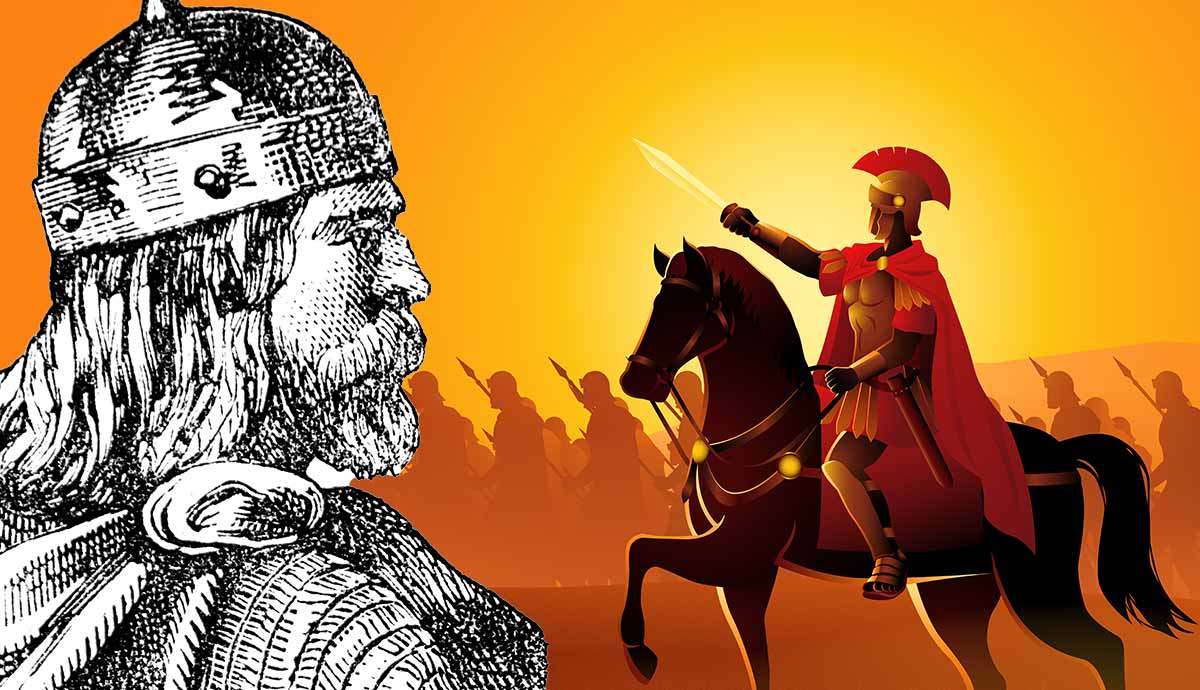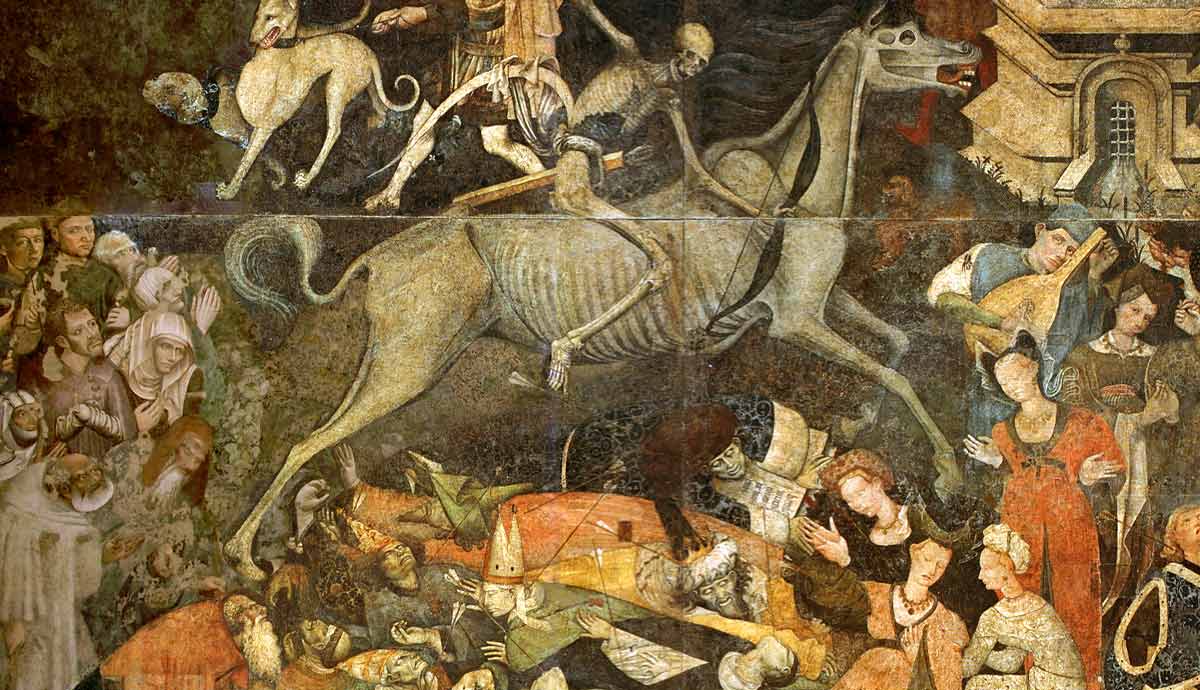0 Comentários
0 Compartilhamentos
147 Visualizações

Diretório
Elevate your Sngine platform to new levels with plugins from YubNub Digital Media!
-
Faça o login para curtir, compartilhar e comentar!
-
 WWW.THECOLLECTOR.COMWas King Arthur Based on the Roman Officer Lucius Artorius Castus?One of many modern theories about the origin of the legends of King Arthur is that they can be traced back to the activities of a Roman officer in Britain. His name was Lucius Artorius Castus. He lived long before the traditional Arthurian period, but some theorists argue that he was the original historical person who inspired the story of the legendary king. What is the evidence to support this theory, and why is it rejected by most modern Arthurian scholars?Why Would King Arthur Have Been Lucius Artorius Castus?Memorial inscription of Lucius Artorius Castus, from Podstrana, Croatia, c. late 2nd or early 3rd century CE. Source: Lucius Artorius Castus: A SourcebookThis theory is based on four key pieces of evidence. Firstly, Lucius Artorius Castus is the only person named Artorius, the origin of the name Arthur, who is known to have served in Britain in a prominent position before the earliest traces of the Arthurian legend.Secondly, a prominent part of the legend recorded by Geoffrey of Monmouth in c. 1137 is that King Arthur went on some exploits on the continent. He allegedly fought a war against the Romans in Gaul. However, the extensive historical record written by Gregory of Tours makes it clear that such a thing never occurred in the 6th century, the traditional Arthurian period. For this reason, many scholars have argued that Geoffrey of Monmouths King Arthur is actually a composite figure. According to this idea, the story of the incursion into Gaul was likely taken from an earlier figure who really did do something like that. Then, somehow, the activities of that earlier figure were combined with those of a 6th-century Arthur figure. Supposedly, the activities of Lucius Artorius Castus can explain the Gallic invasion claims.Sarmatian cavalry depicted on Trajans Column, Rome, c. 2nd century CE. Source: Wikimedia CommonsThe third reason why Lucius Artorius Castus has been connected to King Arthur is that he was supposedly associated with the Sarmatians. About 5,000 of them were sent to Britain after being subdued by the Romans in 175 CE, about the time of Castus. According to proponents of the Castus theory, their myths and legends bore some striking similarities to stories found in the Arthurian legends. Hence, the fact that they came to Britain in Castus time supposedly means that their traditions could have become attached to him.Finally, Castus supposedly occupied a very prominent position in Britain. He was based at Eboracum, or York, which was one of the most prominent cities in Roman Britain and was the capital of the British province. The fact that Castus had such prominence means that it would have been easy for legends to develop around him. Proponents of this theory argue that he led the Sarmatians into battle against the northern tribes during the attested wars of the late 2nd century CE.What Do We Really Know About Lucius Artorius Castus?Fishergate Bar, York, the city at which Lucius Artorius Castus was stationed. Source: Chris Downer, via GeographIt is with good reason that the majority of scholars reject any connection between Lucius Artorius Castus and King Arthur. Firstly, let us examine what we really know about him. He does not appear in any literary source. The key source for him is an inscribed stone that provides a summary of his career. One of the most crucial details on the stone for Arthurian theorists is the fact that he was made the prefect of the Sixth Legion Victrix. This was stationed at Eboracum, or York, in Britain. Therefore, this shows that Castus had a prominent position in Britain.Furthermore, just after mentioning this part of his career, the stone inscription mentions that he led troops from British legions against an enemy. The stone is broken at this point, with the enemy being recorded as ARM___S. According to one theory, this should be restored as Armoricos, meaning the inhabitants of Armorica. This would mean that Castus led troops from Britain to Gaul, just like King Arthur supposedly did.Was Lucius Artorius Castus Really a Prominent Roman General?Distance slab set up by the Sixth Legion Victrix marking the completion of a section of the Antonine Wall, from Cleddans, Scotland, c. 2nd century CE. Source: Wikimedia CommonsWhat did being the prefect of the Sixth Legion Victrix really involve? The truth is that this position meant that Castus was in charge of overseeing the legionary base. He did not, generally speaking, lead any troops into battle. In the hierarchy of the legion, two officers above Castus would need to be out of action in order for Castus to take over as military general. Hence, there is no evidence that Castus was directly involved in any of the wars that took place against the northern tribes in that era.The fact that there is no reason to believe that Castus was directly involved in those wars is important. This means that there is no reason to conclude that he could have anything to do with the legends of King Arthur fighting wars in the north of Britain. Furthermore, it makes it very difficult to see why he would have been special in any significant way to the Sarmatian troops who had been sent to Britain. The idea that he led Sarmatian troops into battle in Britain is simply not supported by the available evidence.Issues With the Gallic InvasionA rock relief of King Vologases III of the Parthian Empire, whose successor Vologases IV had a son who ruled over Armenia and fought against the Romans, Iran, c. 2nd century CE. Source: Wikimedia CommonsFurthermore, what about the idea that Castus took troops from Britain to fight a war in Armorica? Could the Castus identification really potentially explain King Arthurs legendary war in Gaul? If so, this would lend credence to the idea that he was at least partially the origin of the legendary figure of King Arthur.But the enemies listed on the memorial stone are problematic. As we saw earlier, it appears as ARM____S. The earliest drawing of Castus memorial stone, produced in 1850, indicates that there was a ligatured E attached to the end of ARM. This is supported by the fact that the ethnonym Armoricos is not attested on any comparable memorial inscription. This would suggest that the inscription actually refers to the Armenios, not the Armoricos. In other words, Castus did not fight a war in Armorica, Gaul, but in Armenia, far away from Gaul. If this is the case, there is no connection with King Arthurs legendary invasion of Gaul.The Lucius Artorius Castus inscription with the restored text by Christopher Gwinn. Source: Lucius Artorius Castus: A SourcebookThere is significant support for the conclusion that Castus actually went to Armenia rather than Armorica. For one thing, unlike Armoricos, we do find forms of the ethnonym Armenios on comparable stone inscriptions from the Roman era. Furthermore, throughout the mid-2nd to the mid-3rd centuries, the Romans fought several significant wars in Armenia. This covers all the periods in which Castus is believed to have lived.Notably, there is a record that in 161 CE, the Romans sent the governor of Britain, named Statius Priscus, to participate in one of the wars in Armenia. The fact that the Romans are known to have sent such a prominent figure from Britain to Armenia supports the suggestion that the same thing occurred with Castus. Many scholars, if not the majority, now believe that Castus was sent along with Priscus in 161. In contrast, there is nothing to recommend the view that Castus led troops to Armorica, as required by the theory connecting him to King Arthur.The Fatal Flaw in the Sarmatian ConnectionMap of the Parthian Empire under Mithridates II at the start of the 1st century BCE, about three centuries before Lucius Artorius Castus fought against it in Armenia. Source: Wikimedia CommonsThe conclusion that Lucius Artorius Castus went to Armenia in 161 has further consequences for the theory connecting him to King Arthur. A key part of the theory is that the Sarmatians, whose legends are supposedly similar to the legends of King Arthur, were closely associated with Lucius Artorius Castus. This obviously requires them to have been present in Britain at the same time as Castus. The problem is that the Sarmatians were sent to Britain in 175 CE. If Castus left for Armenia in 161, which does appear to be the case, then he was already long gone by the time the Sarmatians arrived. This means that he cannot have had anything to do with them.The memorial inscription supports this conclusion. Based on the style of the stone, the majority of scholars agree that it dates to the Antonine Period, which ended in 192. The wording on the stone is also consistent with this period.Notice that this stone was carved during the Antonine Period, yet Castus left Britain long before the end of his career. This strongly supports the aforementioned chronology of Castuss life, placing his departure from Britain in 161.Why King Arthur Was Not Based on Lucius Artorius CastusA second inscription mentioning Lucius Artorius Castus, Croatia, c. 2nd century CE. Source: Lucius Artorius Castus: A SourcebookIn conclusion, there is good reason to reject the theory that Lucius Artorius Castus had anything to do with the legends of King Arthur. Far from being a prominent battle leader in Britain, Castus was the prefect of the Sixth Legion Victrix. As such, he may well have never seen battle in Britain at all. Furthermore, the idea that he led troops from Britain to Gaul is very unlikely. The evidence more convincingly supports the conclusion that he was sent to Armenia, which does not feature in the Arthurian legends.In addition, this would mean that he was already gone from Britain before the Sarmatians were sent there. Thus, even if the Sarmatian legends could be connected to the Arthurian legends, this would not support the Castus theory. There is no convincing reason why those legends should have found themselves attached to Castus. All things considered, there is no reason to associate Lucius Artorius Castus with King Arthur. However, there are several other historical figures to be considered.0 Comentários 0 Compartilhamentos 148 Visualizações
WWW.THECOLLECTOR.COMWas King Arthur Based on the Roman Officer Lucius Artorius Castus?One of many modern theories about the origin of the legends of King Arthur is that they can be traced back to the activities of a Roman officer in Britain. His name was Lucius Artorius Castus. He lived long before the traditional Arthurian period, but some theorists argue that he was the original historical person who inspired the story of the legendary king. What is the evidence to support this theory, and why is it rejected by most modern Arthurian scholars?Why Would King Arthur Have Been Lucius Artorius Castus?Memorial inscription of Lucius Artorius Castus, from Podstrana, Croatia, c. late 2nd or early 3rd century CE. Source: Lucius Artorius Castus: A SourcebookThis theory is based on four key pieces of evidence. Firstly, Lucius Artorius Castus is the only person named Artorius, the origin of the name Arthur, who is known to have served in Britain in a prominent position before the earliest traces of the Arthurian legend.Secondly, a prominent part of the legend recorded by Geoffrey of Monmouth in c. 1137 is that King Arthur went on some exploits on the continent. He allegedly fought a war against the Romans in Gaul. However, the extensive historical record written by Gregory of Tours makes it clear that such a thing never occurred in the 6th century, the traditional Arthurian period. For this reason, many scholars have argued that Geoffrey of Monmouths King Arthur is actually a composite figure. According to this idea, the story of the incursion into Gaul was likely taken from an earlier figure who really did do something like that. Then, somehow, the activities of that earlier figure were combined with those of a 6th-century Arthur figure. Supposedly, the activities of Lucius Artorius Castus can explain the Gallic invasion claims.Sarmatian cavalry depicted on Trajans Column, Rome, c. 2nd century CE. Source: Wikimedia CommonsThe third reason why Lucius Artorius Castus has been connected to King Arthur is that he was supposedly associated with the Sarmatians. About 5,000 of them were sent to Britain after being subdued by the Romans in 175 CE, about the time of Castus. According to proponents of the Castus theory, their myths and legends bore some striking similarities to stories found in the Arthurian legends. Hence, the fact that they came to Britain in Castus time supposedly means that their traditions could have become attached to him.Finally, Castus supposedly occupied a very prominent position in Britain. He was based at Eboracum, or York, which was one of the most prominent cities in Roman Britain and was the capital of the British province. The fact that Castus had such prominence means that it would have been easy for legends to develop around him. Proponents of this theory argue that he led the Sarmatians into battle against the northern tribes during the attested wars of the late 2nd century CE.What Do We Really Know About Lucius Artorius Castus?Fishergate Bar, York, the city at which Lucius Artorius Castus was stationed. Source: Chris Downer, via GeographIt is with good reason that the majority of scholars reject any connection between Lucius Artorius Castus and King Arthur. Firstly, let us examine what we really know about him. He does not appear in any literary source. The key source for him is an inscribed stone that provides a summary of his career. One of the most crucial details on the stone for Arthurian theorists is the fact that he was made the prefect of the Sixth Legion Victrix. This was stationed at Eboracum, or York, in Britain. Therefore, this shows that Castus had a prominent position in Britain.Furthermore, just after mentioning this part of his career, the stone inscription mentions that he led troops from British legions against an enemy. The stone is broken at this point, with the enemy being recorded as ARM___S. According to one theory, this should be restored as Armoricos, meaning the inhabitants of Armorica. This would mean that Castus led troops from Britain to Gaul, just like King Arthur supposedly did.Was Lucius Artorius Castus Really a Prominent Roman General?Distance slab set up by the Sixth Legion Victrix marking the completion of a section of the Antonine Wall, from Cleddans, Scotland, c. 2nd century CE. Source: Wikimedia CommonsWhat did being the prefect of the Sixth Legion Victrix really involve? The truth is that this position meant that Castus was in charge of overseeing the legionary base. He did not, generally speaking, lead any troops into battle. In the hierarchy of the legion, two officers above Castus would need to be out of action in order for Castus to take over as military general. Hence, there is no evidence that Castus was directly involved in any of the wars that took place against the northern tribes in that era.The fact that there is no reason to believe that Castus was directly involved in those wars is important. This means that there is no reason to conclude that he could have anything to do with the legends of King Arthur fighting wars in the north of Britain. Furthermore, it makes it very difficult to see why he would have been special in any significant way to the Sarmatian troops who had been sent to Britain. The idea that he led Sarmatian troops into battle in Britain is simply not supported by the available evidence.Issues With the Gallic InvasionA rock relief of King Vologases III of the Parthian Empire, whose successor Vologases IV had a son who ruled over Armenia and fought against the Romans, Iran, c. 2nd century CE. Source: Wikimedia CommonsFurthermore, what about the idea that Castus took troops from Britain to fight a war in Armorica? Could the Castus identification really potentially explain King Arthurs legendary war in Gaul? If so, this would lend credence to the idea that he was at least partially the origin of the legendary figure of King Arthur.But the enemies listed on the memorial stone are problematic. As we saw earlier, it appears as ARM____S. The earliest drawing of Castus memorial stone, produced in 1850, indicates that there was a ligatured E attached to the end of ARM. This is supported by the fact that the ethnonym Armoricos is not attested on any comparable memorial inscription. This would suggest that the inscription actually refers to the Armenios, not the Armoricos. In other words, Castus did not fight a war in Armorica, Gaul, but in Armenia, far away from Gaul. If this is the case, there is no connection with King Arthurs legendary invasion of Gaul.The Lucius Artorius Castus inscription with the restored text by Christopher Gwinn. Source: Lucius Artorius Castus: A SourcebookThere is significant support for the conclusion that Castus actually went to Armenia rather than Armorica. For one thing, unlike Armoricos, we do find forms of the ethnonym Armenios on comparable stone inscriptions from the Roman era. Furthermore, throughout the mid-2nd to the mid-3rd centuries, the Romans fought several significant wars in Armenia. This covers all the periods in which Castus is believed to have lived.Notably, there is a record that in 161 CE, the Romans sent the governor of Britain, named Statius Priscus, to participate in one of the wars in Armenia. The fact that the Romans are known to have sent such a prominent figure from Britain to Armenia supports the suggestion that the same thing occurred with Castus. Many scholars, if not the majority, now believe that Castus was sent along with Priscus in 161. In contrast, there is nothing to recommend the view that Castus led troops to Armorica, as required by the theory connecting him to King Arthur.The Fatal Flaw in the Sarmatian ConnectionMap of the Parthian Empire under Mithridates II at the start of the 1st century BCE, about three centuries before Lucius Artorius Castus fought against it in Armenia. Source: Wikimedia CommonsThe conclusion that Lucius Artorius Castus went to Armenia in 161 has further consequences for the theory connecting him to King Arthur. A key part of the theory is that the Sarmatians, whose legends are supposedly similar to the legends of King Arthur, were closely associated with Lucius Artorius Castus. This obviously requires them to have been present in Britain at the same time as Castus. The problem is that the Sarmatians were sent to Britain in 175 CE. If Castus left for Armenia in 161, which does appear to be the case, then he was already long gone by the time the Sarmatians arrived. This means that he cannot have had anything to do with them.The memorial inscription supports this conclusion. Based on the style of the stone, the majority of scholars agree that it dates to the Antonine Period, which ended in 192. The wording on the stone is also consistent with this period.Notice that this stone was carved during the Antonine Period, yet Castus left Britain long before the end of his career. This strongly supports the aforementioned chronology of Castuss life, placing his departure from Britain in 161.Why King Arthur Was Not Based on Lucius Artorius CastusA second inscription mentioning Lucius Artorius Castus, Croatia, c. 2nd century CE. Source: Lucius Artorius Castus: A SourcebookIn conclusion, there is good reason to reject the theory that Lucius Artorius Castus had anything to do with the legends of King Arthur. Far from being a prominent battle leader in Britain, Castus was the prefect of the Sixth Legion Victrix. As such, he may well have never seen battle in Britain at all. Furthermore, the idea that he led troops from Britain to Gaul is very unlikely. The evidence more convincingly supports the conclusion that he was sent to Armenia, which does not feature in the Arthurian legends.In addition, this would mean that he was already gone from Britain before the Sarmatians were sent there. Thus, even if the Sarmatian legends could be connected to the Arthurian legends, this would not support the Castus theory. There is no convincing reason why those legends should have found themselves attached to Castus. All things considered, there is no reason to associate Lucius Artorius Castus with King Arthur. However, there are several other historical figures to be considered.0 Comentários 0 Compartilhamentos 148 Visualizações -
 WWW.DUALSHOCKERS.COM10 Best Games Where You're The Final BossA games final boss encounter is the big, super-duper climax of the story. Its a narrative payoff, one final test of everything youve learned over the course of the game, like fighting Vergil at the end of Devil May Cry 3.0 Comentários 0 Compartilhamentos 141 Visualizações
WWW.DUALSHOCKERS.COM10 Best Games Where You're The Final BossA games final boss encounter is the big, super-duper climax of the story. Its a narrative payoff, one final test of everything youve learned over the course of the game, like fighting Vergil at the end of Devil May Cry 3.0 Comentários 0 Compartilhamentos 141 Visualizações -
 WWW.PCGAMESN.COMNew Path of Exile 2 teaser hints at the ARPG's next major updatePath of Exile 2 Season 3 has crept up on me somewhat. There are so many excellent ARPGs on the calendar nowadays, from the reliable heavy hitters like Diablo 4 and PoE to strong indie challengers such as The Slormancer and Hell Clock. Ive just started playing the newly released Titan Quest 2, and I'm having a blast, but now Grinding Gear Games has reignited the flames of anticipation as it prepares to launch the next PoE 2 update. A new, cryptic image has sent the community into speculation mode, and could well hint at the arrival of the fourth act of the Path of Exile 2 campaign. Continue reading New Path of Exile 2 teaser hints at the ARPG's next major updateMORE FROM PCGAMESN: Path of Exile 2 builds, Path of Exile 2 classes, Path of Exile 2 quests0 Comentários 0 Compartilhamentos 146 Visualizações
WWW.PCGAMESN.COMNew Path of Exile 2 teaser hints at the ARPG's next major updatePath of Exile 2 Season 3 has crept up on me somewhat. There are so many excellent ARPGs on the calendar nowadays, from the reliable heavy hitters like Diablo 4 and PoE to strong indie challengers such as The Slormancer and Hell Clock. Ive just started playing the newly released Titan Quest 2, and I'm having a blast, but now Grinding Gear Games has reignited the flames of anticipation as it prepares to launch the next PoE 2 update. A new, cryptic image has sent the community into speculation mode, and could well hint at the arrival of the fourth act of the Path of Exile 2 campaign. Continue reading New Path of Exile 2 teaser hints at the ARPG's next major updateMORE FROM PCGAMESN: Path of Exile 2 builds, Path of Exile 2 classes, Path of Exile 2 quests0 Comentários 0 Compartilhamentos 146 Visualizações -
 WWW.PCGAMESN.COMHow to make a smoothie in Grow a GardenHow do you make a smoothie in Grow a Garden? If Chris. P wants to cool down after a long day of stuffing his face, this is the treat to tackle. Added in the second leg of the Roblox game's big cooking event, these Grow a Garden smoothie recipes can be whipped up in around six minutes with some very easy crops.Even if you miss his smoothie craving window, you can use any mutated smoothies in Grow a Garden to score some unique Roblox rewards from the rat opposite Chris P. Still eager to please the piggy? Stock up to score big by learning how to make salad or how to make a burger in Grow a Garden, too. Continue reading How to make a smoothie in Grow a GardenMORE FROM PCGAMESN: Best Roblox games, Roblox promo codes, Roblox music codes0 Comentários 0 Compartilhamentos 145 Visualizações
WWW.PCGAMESN.COMHow to make a smoothie in Grow a GardenHow do you make a smoothie in Grow a Garden? If Chris. P wants to cool down after a long day of stuffing his face, this is the treat to tackle. Added in the second leg of the Roblox game's big cooking event, these Grow a Garden smoothie recipes can be whipped up in around six minutes with some very easy crops.Even if you miss his smoothie craving window, you can use any mutated smoothies in Grow a Garden to score some unique Roblox rewards from the rat opposite Chris P. Still eager to please the piggy? Stock up to score big by learning how to make salad or how to make a burger in Grow a Garden, too. Continue reading How to make a smoothie in Grow a GardenMORE FROM PCGAMESN: Best Roblox games, Roblox promo codes, Roblox music codes0 Comentários 0 Compartilhamentos 145 Visualizações -
 WWW.MASHED.COMRecreate Sizzler's Legendary Cheese Toast Right In Your KitchenOur copycat Sizzler's cheese toast recipe whips up in under 15 minutes with only 4 ingredients, and might just be better than the original version.0 Comentários 0 Compartilhamentos 162 Visualizações
WWW.MASHED.COMRecreate Sizzler's Legendary Cheese Toast Right In Your KitchenOur copycat Sizzler's cheese toast recipe whips up in under 15 minutes with only 4 ingredients, and might just be better than the original version.0 Comentários 0 Compartilhamentos 162 Visualizações -
 WWW.MASHED.COM12 Times The FDA Forced Fast Food Menu ChangesIt's no secret that fast food isn't the healthiest cuisine, but at times it's been downright dangerous, prompting the FDA to intervene.0 Comentários 0 Compartilhamentos 158 Visualizações
WWW.MASHED.COM12 Times The FDA Forced Fast Food Menu ChangesIt's no secret that fast food isn't the healthiest cuisine, but at times it's been downright dangerous, prompting the FDA to intervene.0 Comentários 0 Compartilhamentos 158 Visualizações -
WWW.THEKITCHN.COMThe "Unforgettable" Tequila Cocktail My Friends Always Ask Me to MakeThe jalapeo simple syrup is key.READ MORE...0 Comentários 0 Compartilhamentos 160 Visualizações
-
 WWW.THEKITCHN.COM16 Recipes You Can Make in Your MicrowaveIt's capable of a lot more than you think.READ MORE...0 Comentários 0 Compartilhamentos 158 Visualizações
WWW.THEKITCHN.COM16 Recipes You Can Make in Your MicrowaveIt's capable of a lot more than you think.READ MORE...0 Comentários 0 Compartilhamentos 158 Visualizações -
 WWW.BGR.COM5 Of The Best Cheap Electric Bikes For Adults You Can Get On Amazon (According To Users)Not all e-bikes are expensive! You can actually get these cheap electric bikes for a few hundred dollars, and we found the five best ones on Amazon.0 Comentários 0 Compartilhamentos 157 Visualizações
WWW.BGR.COM5 Of The Best Cheap Electric Bikes For Adults You Can Get On Amazon (According To Users)Not all e-bikes are expensive! You can actually get these cheap electric bikes for a few hundred dollars, and we found the five best ones on Amazon.0 Comentários 0 Compartilhamentos 157 Visualizações




